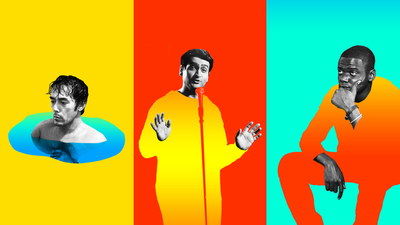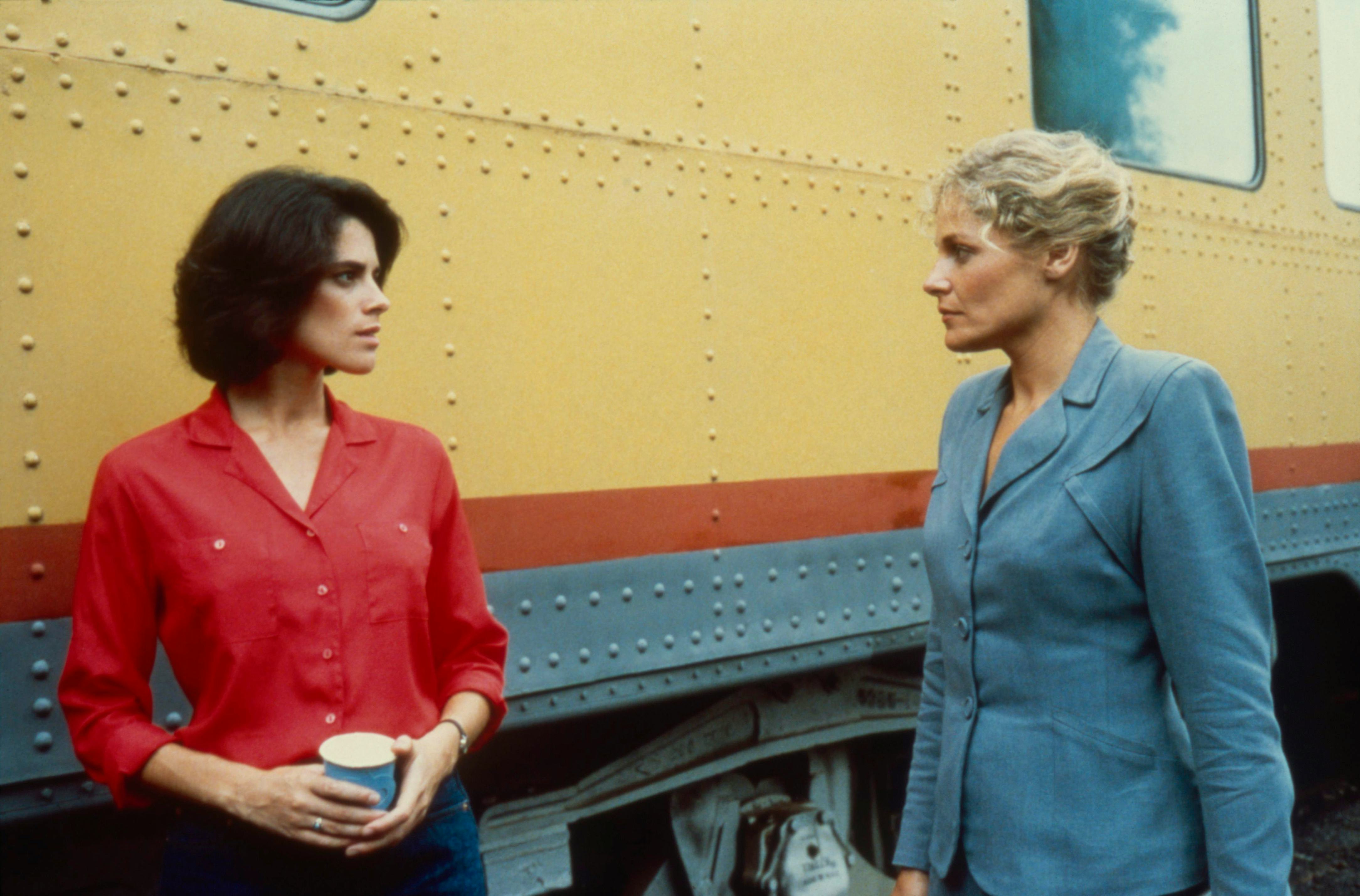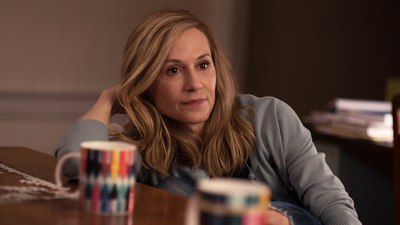
BY MATTHEW ENG |
It's Time to Rediscover DESERT HEARTS, the Landmark Lesbian Romance that Changed Queer Cinema Forever
A classic love story from the queer film canon reemerges.

One of the most exquisitely swooning images I’ve ever encountered on the big screen occurs exactly an hour into Desert Hearts, Donna Deitch’s tenderly subversive love story that is back in theaters with a lush 4K restoration from Janus Films. In the shot, Cay Rivvers (Patricia Charbonneau), a self-confident sculptor with the coltish energy of an inveterate tomboy, is seen in close-up profile, dreamily staring out a window as the soft blue of early evening pours into the smoky casino of her sedate Reno town. With one lingering, heartsick dissolve, Vivian Bell (Helen Shaver), a repressed Columbia professor in town for a quickie divorce, walks through her hotel room, crossing the screen from left to right and literally passing through the mind of her distant and regretful beloved.
This elegant illustration of yearning lesbian devotion is what made Desert Hearts such a radical proposition when it first debuted at the Telluride Film Festival in 1985. More than three decades later, Deitch’s first and only narrative feature remains the rare queer film defined not by persecution but romance and the rare queer romance disrupted not by tragedy but equally specific and thus equally valid personal differences.
Deitch sat down to reflect on the scrappy production and passionately enduring legacy of her trailblazing film and the gritty but hopeful realities of independent filmmaking, then and now.

How often have you revisited Desert Hearts in the past 32 years? How has your relationship to the film evolved since its debut?
It depends on what’s happening. I first sold it to the Samuel Goldwyn Company for a 20-year lease. I was very involved in that time during the first few years and then it just sort of [went] on its own. But then when the lease [ended], I was able to sell it again on another lease. And then I was heavy into revisiting it because we came out with a new DVD. That lease went on for ten years. And then I fell away from it. But then the lease came up again and that resulted in the sale to Criterion. In anticipation of this sale, I got very involved because I always wanted it to end up at Criterion.
Does re-watching it unearth any new discoveries?
The best way to watch it — the most fun and invigorating way — is with an audience. Whenever it shows with an audience, I watch it. And that’s really exciting. There are a lot of laughs in it and there’s an energy in the room with an audience that you don’t get on your own. I don’t watch it on my own at all. I wouldn’t think of doing that.
How did you initially come across Jane Rule’s novel, Desert of the Heart? I know that Rule’s story was altered significantly by the time it reached the screen, but how did the narrative develop in the pre-production process, particularly in your collaboration with screenwriter Natalie Cooper.
I wanted to make a lesbian love story that did not end in a bisexual triangle or death. I was thinking about writing it and looking around. And someone gave me this book, Desert of the Heart. I read that book seven times in a row and I thought, This is the story. This will tell the story I want to tell. So I reached out to Jane Rule and optioned the book. She had some other offers from Hollywood but she didn’t want them because she thought [the book] would be destroyed. And she liked me. She liked my work. So she allowed me to option the book.
I wrote the script initially and raised all the money, based on my script. But I always had the feeling that my script could be a lot better. And I began looking around for a screenwriter to rewrite me, most specifically in the dialogue. And that’s how I found Natalie. I just put it out to the agents that I was looking for a certain type of writer. I talked to them and described [what I was looking for] and read samples. And Natalie was the one.
Was it a true collaboration or was it something she worked on separately?
It was a true collaboration. She read my script and I talked with her about what I felt were its problems and how it could be better. I took her to Reno and the locations where I was going to shoot.
So you had mapped those out even before she came onboard?
Yes! I wanted her to see everything. She lived in Oakland and I lived in L.A. And every weekend, I would fly [to her] and she would slide ten pages across the table to me. And that’s how we did it. She loved to eat and this would always be over a meal. We’d spend the weekend together, talking about everything. And then I’d go home. And the next weekend I’d be back again.
Did you or any of your fellow filmmakers ever acknowledge that you were all in the midst of creating something truly groundbreaking? Or were you just focused on the production at-hand?
It’s both in a way. I made the movie I wanted to see. I was prompted to do that as a filmmaker. I hadn’t seen a movie like this. In some way I knew that it was going to be different from anything that had been made to-date. But of course you can’t predict how that’s going to play. But I knew that it would be different. In terms of how it was going to go, in terms of its release, I didn’t know. But the process really demands that you stay focused on what you’re doing. You can’t think about the outcome, the future, all of that. And I was pretty much in the process.
It took me two-and-a-half years to get the money. During that time, I was speaking [about the film] in a slightly hyperbolic way, I guess. [Laughs] That was in order to sell it as what it could be. Once I raised the money and started the work of prepping the movie, all of that just disappeared.

One of the reasons I’m amazed that the film was even made is that there are no Hollywood stars involved in the project, a decision that I think would make this film difficult to get off the ground even — or especially — today. The benefit of that is the performances you obtained from this ensemble all feel remarkably lived-in and utterly a part of this time and place, which is of course due to the actress’ talents but is also aided by our lack of familiarity. How did you settle on Helen Shaver and Patricia Charbonneau in particular?
Each is a little bit different. I had an incredible casting director, Tim Flack, who is no longer with us. I first met Patricia in New York. We were looking in L.A. and New York. I was sitting in a casting office. And you’re sitting there with tons of 8x10 photos on the table and you’re looking through them. And there was Patricia. The moment I saw that photo, I just said, “Hey, look at this! This is who it is! This is Cay Rivvers.” And they said, “Well, what do you mean now? She’s never done a movie.” And I read her résumé, I saw that. But I said, “This is how I imagine her. And I’d like to meet her.” So they brought her in, she auditioned, and I said, “That’s it, she’s the one.” They told me to test her, but I said I didn’t need to test her. I knew she was the one. And that was how that ball got rolling.
Back in L.A., I was obviously reading a lot of actors for the part of Vivian Bell. I had narrowed it down to three, Helen being one of them. I flew Patricia out. It was very important to me that these two have chemistry. And chemistry is a thing you can’t really predict. You need to see it in the room. You can imagine and hope for it. But you don’t know until you see it. And I felt Helen was perfect for this part and when she and Patricia read together, I felt that this was the perfect combination. You could feel it. It was there in the room.
At that time, in the mid-eighties, there were a lot of actors who didn’t want anything to do with this movie. Actually, first they told the casting directors and their agents about that they were interested in the movie. And then the agents told them not to be in it because it was so controversial. And the controversy extended beyond just the two characters who would become lovers. It was an all-around controversial movie that a lot of people just didn’t want to be in. But Tim found the actors. Some of them declined to come in. Others didn’t. And I think we ended up with the best possible cast.
I also really admired the late Audra Lindley and Andra Akers, two incredibly resourceful character actresses who had rarely been handed film roles as sizable as these during their careers. How did they come onboard?
Audra was the real known quantity when we were in Reno. We were always staying in the same motel. It was one of those motels where all the rooms are ground-level. And Audra was the only one who got her bed changed three times a week because she was famous. I knew who she was. And so when Tim brought her in, it was so startling to me because she was just perfect. And everything about the [on screen] relationship [with Patricia] was just a miracle. She even invested in the film. We were out there shooting one day and she said, “Donna, I’ve really got to have another take.” And I said, “Yeah, but I really need to have another share.” Because I didn’t even have an editor at that point. And so she said, “I’ll buy it.” And when she came to the wrap party, she had a check for $15,000 to buy that share.
Audra and Andra Akers were Tim’s ideas. And when an actor comes in and auditions — although I don’t think I auditioned Audra, I think we just had a conversation — you can feel a consensus in the room. In my casting room, it was just Tim and me. But it became very obvious that these two were right. It’s almost chemical, you know? It’s quite visceral. You feel it and you know at that moment. When you’re in a casting session, that’s what you’re looking for. You’re looking for that moment with every single person where you can feel it viscerally that he or she is the right person.
I’ve been a fan of Robert Elswit for a while and initially had no idea he shot this. And I was struck by the really crisp, picture-postcard beauty of his photography, which I think also adds thematic heft to the film. You get the sense that these classic sights of the American frontier and the open road have been reclaimed for a story about women who rarely get to occupy these settings. How did you two go about devising the film’s visual identity?
I don’t quite remember how I specifically met Robert. It wasn’t an agent kind of thing. It was an introduction between mutual friends. And Robert had not shot that many movies at that point. He had definitely been a D.P. but he had had only half a dozen credits, maybe not even that. But I really hit it off with him. And I had this book of color photographs from the West of cowboys and horses. And I showed this book to Robert and I said, “This is how I see it.” A lot of time you talk about films [with your cinematographer] but I didn’t talk about any films with Robert. I just talked about this book. And I wish I still had it or could get it. I’ve tried to find it over and over again, but I can’t. I’ve Googled every possible subject area and I cannot locate it anywhere. But this book was exactly as I pictured the movie. And the outskirts of Reno and the dude ranch I had selected all lent itself to that. It was all there.
You know, this was also a time before video assist. It was a different way of communicating and doing. It was an entirely different process before video assist. It was video village without the video. So much happened in probably similar ways but also different ways [than they would today] because beforehand so much was communicated and understood verbally. So much time was spent just walking around and talking, which always happens anyway. But we were like this little theater company that went off to Reno and made a movie. That’s what it was like. There wasn’t any coming-and-going of people. There weren’t any agents. It was just our little group. Everybody came at the beginning and left at the end.
The soundtrack also really amplifies the atmosphere of the film in such a potent way. And it's filled with really popular and surely expensive artists, which is rare for any indie film, no matter the time. How did that come about?
When we were shooting, we had a lot of country-western music playing on the set. It was just in the era. And I always thought of country-western music as being what this movie would connect to. When I was in the cutting room with [Robert] Estrin, we started playing around with all of these [singers], from Patsy Cline to Elvis Presley, and even going out of that to Ella Fitzgerald. We were just having fun trying all this different stuff. And that’s kind of the evolution of it, from set to the cutting room. It just seemed to work. But then I found out how expensive it was. And I had to buy it. [Laughs] When you buy music, you have to buy the performance rights but you also have to buy the publishing rights. And people will sometimes buy the publishing rights, but they have this thing called “sound-alikes,” who are hired singers who sound exactly like Elvis Presley and Ella Fitzgerald and are used in order to save money. I didn’t want to do that because so much of this movie is about finding your own authenticity and I just didn’t want to have some fake sound-alike performance. I had to use the real performers. The music was 20-percent of the cost of the movie, which is pretty unusual. It was a big ticket item and I had to raise a lot more money for it.
In this decade alone, I think we’ve seen a considerable surge in lesbian stories on the big screen by filmmakers who hail from many corners of the world, from Blue is the Warmest Color to Carol to Pariah. It’s hard for me to imagine a film like Carol actually existing without the door opened for it by you and Desert Hearts. Is this influence something you have felt or detected in recent years?
I think that the film probably did open some doors. And that’s in part because the film was successful. The film was seen, it was well-distributed. That then leads others to embrace the possibility of making a movie themselves about the subject matter. And the answer is, Yes, it is possible. There are a lot more hurdles to cross but there’s the possibility. There’s a bit of an opening. What would have happened had [Deserts Hearts] not been made? I don’t know. That’s an impossibility. It’s a little difficult for me to talk about [its influence] because I don't really think about it much. It’s more for others to think about. But every step in the right direction — or the left direction — helps. It’s all building blocks to equality.
As someone who stood at the vanguard of the independent film scene during the earliest years of Sundance, how do you feel that world has changed in the decades following Desert Hearts? But also, as someone whose film slightly predated the New Queer Cinema movement, what do you think about the current state of queer cinema, as vast and undefinable as that may be?
I made this film and then, quite unpredictably for me, went into television. Oprah saw the movie and then hired me to direct a four-hour miniseries, [The Women of Brewster Place], and I worked in television for the next 25-plus years. All the while, I wanted to come back to making my own films again. And I see this interim period of all these queer films and gay, lesbian indie filmmakers as being helpful to me, in terms of my return. So many great films have been made and so much has grown in this time. And I feel that’s gonna help me make my next film, which is a sequel to Desert Hearts.
How long has that been in the works?
Well, I always wanted to make [a sequel]. But it’s not a conventional sequel. It takes place in the 1970s in New York City during the women’s liberation movement. It’s all about the world of Desert Hearts, which is a coming-out story and about being your authentic self. And there was a lot of authenticity going on at that time among young women. Young women were really the women who started the movement. So many docs have been made about it, but I always wanted to make a narrative movie set in that time about those women. And I’m currently in the screenwriting stage with another writer.
Going back to your television work, you’ve been fairly prolific as a director in that medium the years since Desert Hearts. Was that always creatively fulfilling for you?
There have always been many, many more male directors than female directors and directors of color. It’s always been that way and the numbers are still pretty bad. So when I was doing it, I was oftentimes the only woman around. I’d be the only woman on the scout, all of that. Directing television is a different job for a director than directing an indie film or any movie. The kings and queens of television are the writers and creators. In movies, they’re the directors. There were many times, during 25-plus years of working all the time, in which I learned a vast amount from writers. Some of the best writers have been and are in television. And it was a great experience for me. To be employed and learning during all that time has been incredible. But I always wanted to make my own films again. Oftentimes, directors in television come in through that episodic door. And I didn’t. So there was something that happened before that I wanted to go back to. And there are stories that I have been dying to tell. I’ve tried to step away a couple of times [to make a movie] but then I wouldn’t get the money so I’d go back. And now I’m rather formally on the path to making my own films. I even have a television series that I’d like to do. But that’s a little bit on the back burner because I don’t want to get too caught up in television. I want to get my film projects off the ground first.

Desert Hearts was made possible by a $20,000 grant from the National Endowment for the Arts, which is currently under siege by our current administration. What do filmmakers stand to lose if funding is cut?
I actually got that grant for another film, a documentary about [photographer] Imogen Cunningham, that I then transferred over to [Desert Hearts] with [the NEA’s] permission. There was more of that kind of money available in that era than now. But now, there are other ways to raise money that never existed then, like Kickstarter, Indiegogo, and all these other social media opportunities. It’s not as though there were so many opportunities that existed then that we don’t have now. They’re just different opportunities. The making of movies has been so democratized. Look at how many more are being made today. So maybe there’s a glut. There’s certainly no shortage of movies being made. It’s definitely tragic that any of these governmental non-profits for the arts are facing cuts and going down. It’s truly tragic. But it doesn’t mean that there aren’t opportunities — and lots of them.

